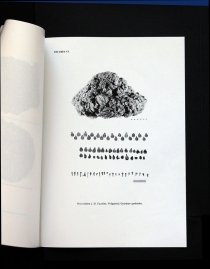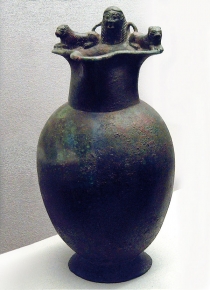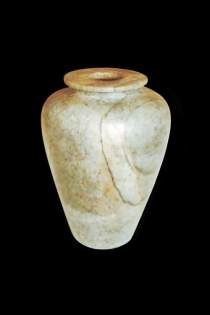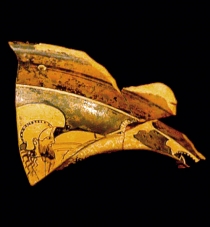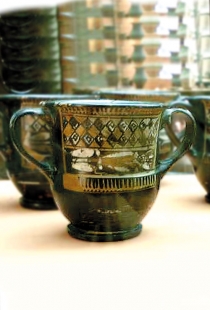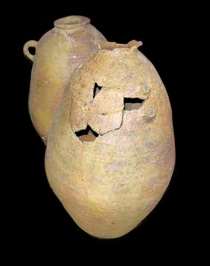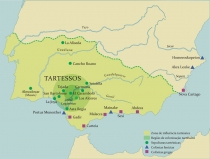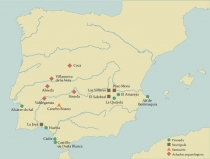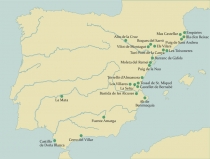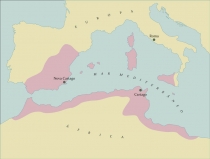Peoples and Wine on the Iberian Peninsula in the Bronze and Iron Ages
There is very little often inadequately substantiated, evidence on the presence of Vitis vinifera in Iberia during the Bronze Age. Rothmaler (1941: 323), however, assumes that some grapevine material survived in Portugal from the Tertiary and has contributed to today’s vine varieties, which form part the national heritage of both Portugal and Spain. Unfortunately, there are gaps in our knowledge on the ethnic origin of the population at that time.
As pollen and grape seed show (Hidalgo 1999: 28 refers to Stevenson) Iberians and Celts began to cultivate grapevines three thousand years ago. In the Museum of Villa Franca del Penedès there is a prehistoric stone wine press which lends credence to this assumption.
There is no fossil evidence to determine the wine consumption of the Neolithic natives (Cardial Culture) to whose presence 5,000 dolmen and numerous menhirs bear witness. In the second millennium BC the Iberian people migrated from North Africa to the Iberian Peninsula. The first millennium BC marks the arrival of the Celts, who have been traditionally associated with wine. We are familiar with their classical “Alodrogica” and “Biturica” grapevine varieties. In Portugal the coming together of these two peoples gave rise to the Lusitanian people. In a rather nebulous way we know that around 2000 BC a very advanced people settled in Iberia. They tended to cultivated vineyards and made wine from them, which they used mainly for trade (ibid.). In the modern historical view the people of the late Bronze Age to early Iron Age who migrated from the East Mediterranean and settled in Southern Spain on the banks of the Guadiana River are described as Tartessian. Their capital was Tartessos in the South, where in addition to trade in wine, they traded in gold products from Scandinavia to the Orient. According to the Bible (I Kings 10: 20 ff; II Chronicles, 9: 21), Israel traded with Tarshish (Tartessos =Τάρτησσος) under King Solomon’s rule. Amaral (1994) suggests that these mentions refer to the original homeland of the Tartessian people. Its silver wealth made Tartessos into a kind of Eldorado of its day. Later the Phoenicians took over the Tartessian trade empire. Bronze wine jugs were found in the La Joya necropolis in Huelva and according to Juan Blánquez, Sebastian Celestino Pérez; Universidad Autónoma de Madrid (2000, in Actas del I Encuentro de Historiadores de la Vitivinicultura Española), further findings are evidence of wine and wine drinking amongst the Tartessians. It is presumed that ancient copper deposits existed in the Tartessos area (the predecessors of today’s open cast mine there. Tin even came from as far afield as Cornwall in England.
In the ninth century BC the Phoenicians established international wine trade, initially in the former Tartessia (Andalusia), where they originally mined silver, and then later in the Ebro Delta and Ibiza, which would seem to indicate widespread viticulture. Some receptacles were made of goat hide, others were clay amphorae, and even alabaster containers were found in Sexi (Almuñécar). Hildalgo assumes that in addition to varieties brought with them from the Orient (Negrul: 30), the Phoenicians also used autochthonous varieties, and evidence suggests the presence of Greek traders from Kios, Miletus and Corinth.
Around 450 BC the Carthaginians took possession of the Peninsula from the Phoenicians. Almost all peoples who colonised the Iberian Peninsula knew about viticulture and the significant trade associated with it. The historical gene pool of grapevine varieties was enriched by the new varieties the Phoenician invaders brought with them. These new varieties were either planted directly as vineyards or bred with the existing local varieties. In this regard, one can only agree with Veiga Ferreira (1993), “We should know more about where grape varieties come from (…) Perhaps we will get the answer to this question one day when our young people want to know”. J. L. Blanco Fernandez (1933, “Les naissances du vin”, L‘Histoire du vin. OIV Paris pp 31 ‑44.) suggests viticulture occurred before the Phoenicians. Today, a complete inventory of grapevine varieties has been made by means of molecular marker techniques. What remains is for these to be systematically compared with other gene pools.
Viticulture merits archaeological attention.
In Portugal itself the dispersal of the grapevine can be traced back to almost 5000 years BP, i.e. to the end of the Cardial Culture. Evidence of this has been found in Alpiarça (*Pais, 1989: 72) in the Tagus Valley region.
Vitis fossils (pollen) discovered in excavations at Paúl dos Patudos date back to 4580 BP, but have a low density. Grapevine pollen fossils with the highest density, of approximately 33%, were also found in Paúl dos Patudos (Alpiarça), albeit dating to 2590 BP.
In the eastern Mediterranean viticulture developed to a high level in the second millennium BC This was possible because there was a range of choice available amongst the grapevine varieties of the one thousand‑year‑old Vitis (E.) vinifera caucasica var. sativa (Vitis vinifera orientalis Negr.). Initially, it was the city state of the Phoenicians (referred to in the Bible as the Land of Canaan), who as a sea‑faring trading nation, traded in the famous Malvasia and Muscatel dessert wines from the islands of Naxos, Crete, Rhodes, Santorini and Cyprus. After the Greeks managed to gain hold of this trade wealth, this wine won enormousacclaimasso‑called“Greekwine”,anamewhich it was able to keep until the Late Middle Ages.
According to Carvalho (1912: 13), “At the time of the Trojan War (1184 BC) the Greeks made considerable profit from wine growing, because the wines with the greatest reputation at the time were those from Marseille (a Greek colony), Kos, Crete (Candia), Lesbos, Esmirna and Chios.” The Phocians (Greeks) had colonies in Sicily, Apulia, Marseille and southern Spain, to which they also brought their “Greek” grapevine varieties (ibid.).
The fossil find in Paúl dos Patudos may relate to the Neolithic Revolution, which was characterised by an upsurge in agriculture and animal husbandry. These occurrences have to be seen in the context of the state of cultivation at the time; in effect this region of pine and oak forests was transformed into tilled, cultivated lands. (Leeuwarden & Jansen, 1985).
The harvesting of grapes for wine making and use as table grapes and raisins can certainly be taken for granted (Barros, 1998). The remarkable site of São Cucufate (Vidigueira) which had been settled since the fourth century BC was excavated in 1982 by Jorge de Alarcão. It was here that he found soil containing seeds and stalks. Silva (1989: 16) identified the 24 seeds found here, measuring 6,9 x 4,2 x 3,1 mm, as those of Vitis vinifera.
In conclusion, one can concur with Amaral (1994: 325): carbonised grape seeds and shoots were found dating to the period of the Bronze Age from 1500 BC to 700 BC. One can therefore assume that viticulture already existed over the entire Iberian Peninsula long before the Romans came. In his works “Periplo Massaliota” and “Oda Maritima”, the Roman geographer, Rufo Festo Avieno (400 BC) has bequeathed to us precise descriptions of various Iberian landscapes, including the vineyards already in existence. In these writings, he makes reference to descriptions by a Greek seafarer of 520 BC.
Until the end of the Bronze Age the ties of the Western world with the advanced Orient continued to be confined to contact with the mercantile sea‑faring nations of the Phoenicians (from Ardos, Byblos, Britos, and Sidon and Tyre in the Land of Canaan). The activity at their own trading posts, or at least the influence of the Phoenicians, permeated to the whole Iberian Peninsula. They had established trade missions in Gádir (Cadíz), Malaka (Malaga, Sexi (Almuñécar) and Abdera (Adra in modern Spain). Clear proof of their presence in Portugal is the large number of Almaraz grape seeds discovered (at Almada in Lisbon) dating back to the seventh century BC The introduction of the “Moscatel de Setúbal” (= of Alexandria) grapevine variety on the peninsula of the same name also speaks of Phoenician presence, as does the piece of gold jewellery found on the banks of the Tagus River (Fig. 23).
Later the Greeks followed them and built their trading houses in Iberia.
From 800 BC the first advanced civilisation of urban character developed in the West: In Italy, North of Rome (modern day Tuscany), the Etruscans to some extent became the intermediaries between the former “barbarous” Gauls and Iberians and the cultivated West.
Etruscan viticulture is very eloquently described on frescoes, dishes and vases. At that time in Gaul wine was a scarce and sought‑after commodity which the Etruscans (based on Luc Long’s discoveries) used to ship from somewhere near “Caera” in Italy to a port near Marseille which no longer exists today. There was much talk in the media a few years ago about a ship from pre‑Roman times that was found buried at a depth of 60 metres off the French coast on the peninsula of Giens. This Etruscan boat was laden with 600 wine amphorae, ingeniously stacked between bronze dishes in elaborate fashion. This discovery is significant in so far as it contributes to improved knowledge about the beginning of West European viticulture independent from that of the Greeks, and also helps to explain not only the sudden rise of the Roman Empire but also the accomplishments of the Etruscans, including those in viticulture, which were assimilated by the Romans. The following Italian grapevine varieties are considered as Etruscan selections of V.Silvestris wild varieties: Lambruschi, Trebbiano, Sangiovese and Montepulciano. Amaral (1994) mentions other grapevine varieties which were cultivated in Gaul by the Celts: Aloborica and Biturica.
In Spain there are many places, such as at the top of Benimàquia, at a significant early archaeological site at Denia (Valencia), where remains of Phoenician culture have been found, including drinking vessels, amphorae and wine presses (600‑400 BC).
Because of its geographical position, Valencia had a lot to do with the sea‑faring nations of Antiquity from a very early date.
At Cabezo Lucero (Alicante), tombs with fragments of Greek vessels which contained possible wine residues (500 BC) were found. At this time trade in wine and wine containers in the western Mediterranean was one of the most important Greek merchant activities and, in turn, led to vines being grown in these regions. Wine presses from 700 BC and 600 BC were excavated at Benimàquia (Dénia), as well as grape seeds and amphorae and other objects, suggestive of Phoenician origin.
In Los Morenos, Alcantarilla, Campo Arcís and El Campello de Monravana (Llíria) wine presses were found hewn out of rock. Juan Piqueras Haba mentions a large number of other items which provide evidence of viticulture before the time of Christ, as do Juan Blánquez and Sebastian Celetino Pérez (Actas del I Encuentro de Historiadores 2000).
In Castillo de Doña Branca, the grape seeds discovered at Jerez were analysed and found to be from the seventh century BC. Various items of evidence from the sixth century BC, such as cups from the Villares (Albacete) necropolis, Cabezo de Lucero (Alicante), Cacho Roano (on the Guadalquivir), and El‑Cigaralejo (Murcia) were also found.
The Greek influence in the sixth century BC (Albacete) is, however, of less significance than the indication that viticulture first became a factor of economic importance with the arrival of the Romans.
We have the Roman Polybius (205‑125 BC), to thank for the first written documents on pre‑Roman viticulture in Portugal; he was amazed at the low prices of Portuguese wines (Amaral, 1994: 327). A. M. da Fonseca (1941), and Spanish authors (Luis Hidalgo 1999) referred to the Greek travel writer Strabo (Στράβων; 64 BC‑AD 24), who in his Geographica(the 1878 translation into Portuguese by (Pereira) had described viticulture as already being of some significance. In particular, he described the Minhotal in Spain and Portugal, and how the discovery of the press at Verin (Galicia) was an archaeological high point.Elsewhere, he reported that consumption wine was an advantage enjoyed by the privileged, as – in the example of the first Portuguese national hero, Viriato (Viriatus, warrior chieftain of the Lusitanians), it was drunk at “large family gatherings, or lavish banquets” Veiga Ferreira (1973: 183). It should be noted that the depiction from the article by Juan Blanques and Sebastián Celestino Pérez, (Proyectos Arquéologicos sobre la utilización social del patrimonio cultural del vino, in Actas del I Encuentro de Historiadores de la Vitivinicultura Española 2000)”, comes from earlier archaeological sites (See Fig. 32).
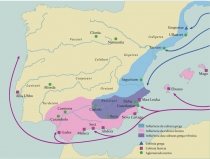 Fig. 31: In the first millennium BC, the Phoenicians and the Greeks regularly traded with the Levantine, a relationship which soon became colonising in nature, with
the inhabitants on the East coast of Spain and the Balearic Islands coming under the influence of both sea-faring peoples. (Winegrowing Congress in Almendralejo, March 2011).
Fig. 31: In the first millennium BC, the Phoenicians and the Greeks regularly traded with the Levantine, a relationship which soon became colonising in nature, with
the inhabitants on the East coast of Spain and the Balearic Islands coming under the influence of both sea-faring peoples. (Winegrowing Congress in Almendralejo, March 2011).


